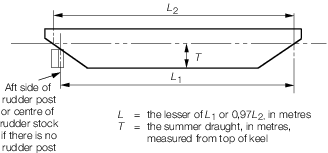
Section
1 General

1.1 Application
1.1.1 This
Chapter applies, in general, to manned or unmanned non-self-propelled
ships defined as follows:
-
Barges for the
carriage of general dry cargoes in cargo holds.
-
Barges for the
carriage of liquid cargoes in bulk.
-
Pontoons designed
specifically for the carriage of non-perishable cargo on deck.
-
Shipborne barges
for the carriage of general dry cargo in cargo holds and intended
to operate afloat only within specified geographical limits, and suitable
for regular carriage on board a larger ship.
1.1.2 Manned
or unmanned barges for the carriage of liquid chemicals in bulk and
barges for the carriage of liquefied gases will receive individual
consideration on the basis of the Rules, see
Table 5.1.1 Applicable Rules.
Table 5.1.1 Applicable Rules
1.1.3 The
scantlings and arrangements, except where otherwise specified in this
Chapter, are to comply with the Rules as indicated in Table 5.1.1 Applicable Rules.
1.1.4 The
Rules assume that the structural arrangements of barges carrying cargo
in holds will generally approximate to normal ship shape and construction.
Barges of this type not doing so will receive individual consideration
on the basis of the Rules.
1.1.5 The
Rules also assume that barges and pontoons are homogeneously loaded.
Barges or pontoons with other types of loading, e.g. crane pontoon,
will receive individual consideration.
1.1.6 All
barges and pontoons are to be fitted with adequate arrangements for
towing. In general, such arrangements are to consist of, or be equivalent
to, not less than two sets of bollards, each of which shall be suitable
for accepting a towline of suitable breaking strength.

1.2 Class notations

1.3 Information required
1.3.1 In addition
to the information and plans required by Pt 3, Ch 1, 5 Information required, the following are to be submitted:
- Details of structure and fittings to which deck cargo securing
lashings, etc. are attached.
- Details of the bollards and their supporting structure.
- Where pusher tugs or integral tug/barge systems are proposed,
full details and data of the attachment and support arrangements.
- Details of the intended service areas required for barges or pontoons
designed to operate within specified geographical limits.
- Longitudinal strength and lifting arrangements for ship-borne
barges.

1.4 Symbols and definitions
1.4.1 The
Rule length, L, for vessels with swim ends is to be measured
as shown in Figure 5.1.1 Definition of Rule length. Where
a swim end is arranged aft but no rudder is fitted, L need
not exceed 97 per cent of the extreme length on the summer load waterline.
For tugs and barge units having rigid connections, the length, L,
is to be taken as the combined length of the tug and barge.

Figure 5.1.1 Definition of Rule length
|
| Copyright 2022 Clasifications Register Group Limited, International Maritime Organization, International Labour Organization or Maritime
and Coastguard Agency. All rights reserved. Clasifications Register Group Limited, its affiliates and subsidiaries and their respective
officers, employees or agents are, individually and collectively, referred to in this clause as 'Clasifications Register'. Clasifications
Register assumes no responsibility and shall not be liable to any person for any loss, damage or expense caused by reliance
on the information or advice in this document or howsoever provided, unless that person has signed a contract with the relevant
Clasifications Register entity for the provision of this information or advice and in that case any responsibility or liability is
exclusively on the terms and conditions set out in that contract.
|
 |
|